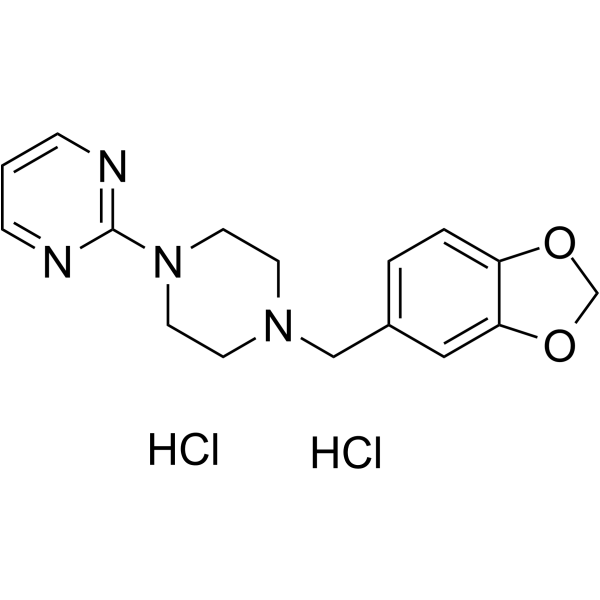1451048-94-4
| Name | 2-[4-(1,3-Benzodioxol-5-ylmethyl)-1-piperazinyl]pyrimidine hydrochloride (1:1) |
|---|---|
| Synonyms |
2-[4-(1,3-Benzodioxol-5-ylmethyl)-1-piperazinyl]pyrimidine hydrochloride (1:1)
2-[4-(1,3-Benzodioxol-5-ylmethyl)piperazin-1-yl]pyrimidine hydrochloride (1:1) Pyrimidine, 2-[4-(1,3-benzodioxol-5-ylmethyl)-1-piperazinyl]-, hydrochloride (1:1) MFCD09971034 |
| Description | Piribedil dihydrochloride is a potent and orally active dopamine D2 and dopamine D3 agonist. Piribedil dihydrochloride is also a α2-adrenoceptors antagonist. Piribedil dihydrochloride can inhibit MLL1 methyltransferase activity (EC50: 0.18 μM). Piribedil dihydrochloride has the potential for the research of parkinson's disease, circulatory disorders, cancers[1][2][3][4]. |
|---|---|
| Related Catalog | |
| Target |
D2 Receptor D3 Receptor |
| In Vitro | Piribedil dihydrochloride (0-160 μM, 7 days) specifically inhibits MLL1 methyltransferase activity and selectively suppresses MLL-r cell proliferation[4]. Piribedil dihydrochloride (0-160 μM, 4 days) selectively decreases the H3K4 methylation in MLL-r cells (THP-1 and MV4;11), by disturbing the MLL1-WDR5 interaction[4]. Piribedil dihydrochloride (0-160 μM, 4 days) induces cell-cycle arrest, apoptosis and differentiation in MLL-r cells (THP-1 and MV4;11)[4]. Cell Viability Assay[4] Cell Line: MLL-r AML cells (THP-1 and MV4;11), non-MLL leukemia cell line (K562) Concentration: 0, 20, 40, 80 and 160 μM Incubation Time: 0-7 days Result: Inhibited the growth rate of the THP-1 and MV4;11 cells in a time-dependent manner. Western Blot Analysis[4] Cell Line: THP-1 and MV4;11 cells Concentration: 0, 20, 40, 80 and 160 μM Incubation Time: 4 days Result: Decreased the levels of H3K4me2 and H3K4me3 without affecting the methylation of other histones, such as H3K79, H3K36 and H3K27. |
| In Vivo | Piribedil dihydrochloride (intraperitoneal injection, 5, 15, 40 mg/kg ) alleviates the L-DOPA-induced dyskinesias in a rat model of Parkinson’s disease[2]. Piribedil dihydrochloride (oral gavage, 4-5 mg/kg, daily for 2 weeks) increases locomotor activity and reversal of motor deficits in adult common marmosets[3]. Piribedil dihydrochloride (oral gavage, 150 mg/kg, daily for 21 days) inhibits MLL-r tumor growth and decreases the expression of MLL1 target genes in MV4;11 tumor xenografts[4]. Animal Model: Rat model of Parkinson’s disease[2] Dosage: 5, 15, 40 mg/kg Administration: Intraperitoneal injection, administered 5 min before administration of L-DOPA. Result: Reduced turning behaviour and AD (axial dystonia), OD (orolingual dyskinesia) and FD (forelimb dyskinesia) at 5 and 40 mg/kg. Increased LD (locomotive dyskinesias) at the 40 mg/kg. Animal Model: Adult common marmosets[3] Dosage: 4-5 mg/kg Administration: Oral gavage, daily for 2 weeks Result: Increased vigilance and alertness and reversed the downregulation of preprotachykinin mRNA induced by MPTP in rostral and caudal striatum. |
| References |
| Molecular Formula | C16H19ClN4O2 |
|---|---|
| Molecular Weight | 334.801 |
| Exact Mass | 334.119659 |
